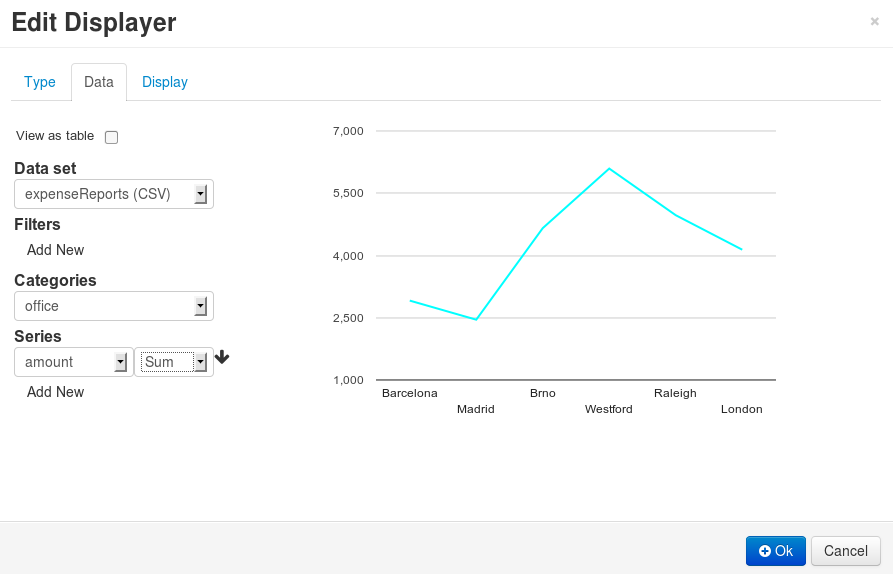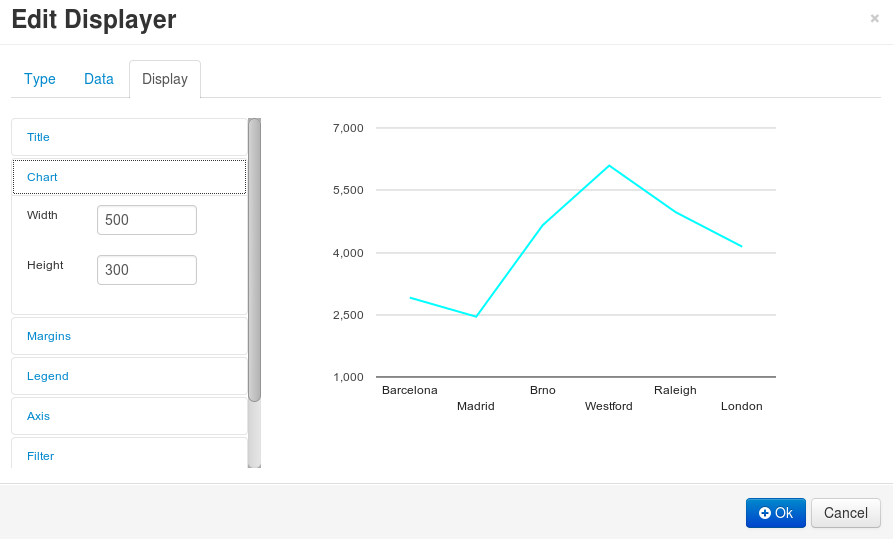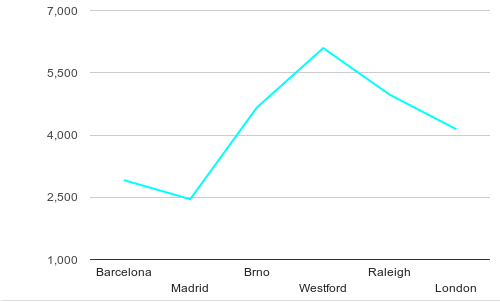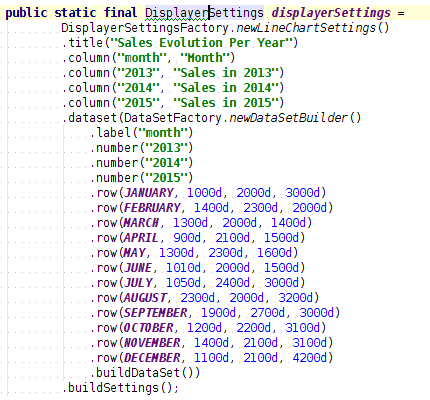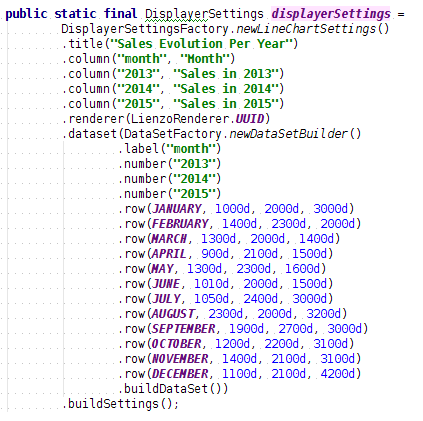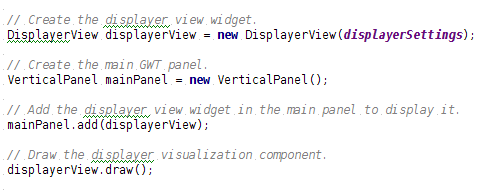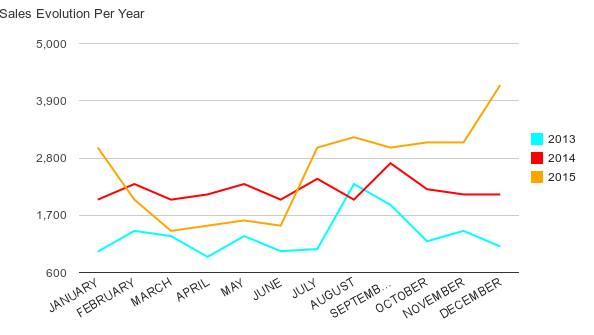More and more data is being collected nowadays, but collecting lots of data does not make any sense until these data can be extracted, analyzed and interpreted to make it understandable for business people. Data visualization is one of the key points of this process: data visualization is the presentation of data in a pictorial or graphical format. There exist several ways of displaying and representing these data such as tables or charts.
Data visualization software is wide extended in the market, there exist lots of libraries that provides the ability to create data tables and all kind of charts. Some of them are proprietary, some open source, some provides specific graphs and others are designed to be used in specific scenarios.
In Dashbuilder, we think the best approach is to be able to adapt to any of those libraries easily. It allows the developer to use all the power of the Dashbuilder's data set API and display the data as user expects, using different data visualization components from different libraries that can be adapted to every situation.
These visualization components that integrate the visualization libraries with Dashbuilder Data Set API are called
Displayers. Dashbuilder provides by default some displayer components, such as the Google bar, pie and table displayers, or the Lienzo bar chart displayer, among others.
Another concept that comes into play is the
Renderer Library: a Dashbuilder component that allows the framework to use any third party data visualization library. It allows the communication between data set API and the way how data is visualized. The goal of a renderer is to provide a Displayer for each of the visualizations supported.
As you can see, data visualization is the last stage in business data analysis; as it's what the end user will see and use to take business decisions. So it's very important to talk about how Dashbuilder renders the data and how it adapts to any situation by integrating and handling third party data visualization libraries.
This article explains the internals of the Dashbuilder rendering subsystem, its architecture and the design of the different components and interfaces involved.
The rendering subsystem
The rendering subsystem in Dashbuilder is the responsible for generating the different kinds of visualization components, such as bar charts, pie charts, area charts, bubble charts, tables, maps and so on.
These are some examples of visualization components provided by default:
 |
| GWT Bar and Pie Charts |
The main advantage of the rendering subsystem is that it's not tied to any visualization library, as it provides a pluggable mechanism in order to use your favorite one.
Data visualization libraries are pluggable. What does that mean?
Dashbuilder is a data visualization framework that provides the ability to query, collect and organize your business data, but its goal is not focused in developing and providing data visualization components on the client side; it just provides the grouped, filtered an sorted data to use in those visualization components, that can be provided by any third party data visualization library.
Summarizing, the rendering subsystem provides a pluggable mechanism that connects the data set API with a data visualization component, and it allows to use any third party library to visualize it.
This external data visualization mechanism is represented by the RendererLibrary interface and managed by the RendererLibLocator as you can see in the following diagram:
 |
| Renderer subsystem main interfaces |
As an example, consider the following two charts. Both display the same chart type and same data but using different data visualization libraries:
GWT and
Lienzo:
 |
| Bar Chart - Lienzo vs GWT |
Renderer Library
A RendererLibrary is a component that displays the data using an specific visualization library. Its main goal is to provide a data Displayer component for each visualization component the visualization library provides.
For example, consider the GWT charting library. As it provides a bar chart, the Dashbulder's Google Renderer library will provide the GoogleBarChartDisplayer. As it provides a pie chart, the Dashbulder's Google Renderer library will provide the PieBarChartDisplayer. And make it extensible for all kind of GWT charts.
The following UML diagram shows an example of a RendererLibrary implementation for Google GWT charting.
In this example, the renderer implementation class is GoogleRenderer (implements Renderer interface) and it provides a GoogleDisplayer based class (implements Displayer interface). Note that GoogleDisplayer class extends some other abstract Google base classes, but it's up to the developer the architecture for it. Dashbuilder just requires to implmenent the Displayer interface for drawing the component.
 |
| Google Renderer & Displayer classes diagram |
As you can see in the diagram above, each RendererLibrary has a unique identifier. But as most important, a RendererLibrary component must provide two methods: draw and redraw, which are used by the framework as: draw method to init & render the visualization for the first time, and redraw to get and display the latest data changes.
It's important to note that each third party data visualization library can provide custom functionality and custom settings for a visualization component that are not present in the same component from another library.
For those interested in developing a new renderer, please just take a look at the current implementations of the GoogleRenderer and LienzoRenderer in GitHub.
Available rendering libraries
Dashbuilder supports by default:
- GWT - Data visualization library that provides several chart types that are build using the popular GWT framework. Provided by Google.
The project is located at Google Code and you can find the gallery here.
- Lienzo - Data visualization library that it's still a prototype under development and not ready to be used in production environments. It provides, at this stage, two chart types: bar & pie. It's tight integrated with Dashbuilder and will provide extended functionality. Keep updated on it!
Note that it's Open Source and distributed by Ahomé Innovation Technologies.
The project is located at GitHub and you can find the gallery here.
These are the visualization components supported by each
Rendering Library:
| Renderer Library | Bar Chart | Pie Chart | Area Chart | Line Chart | Bubble Chart | Meter Chart | Table | Map |
|---|
| GWT | X | X | X | X | X | X | X | X |
| Lienzo | X | X | - | - | - | - | - | - |
IMPORTANT: In future releases we will integrate new renderer libraries in order to support other visualization frameworks such as
D3. Stay tuned!
The rendering process
Once your are familiarized with the basic components in Dashbuilder, let's explain how the rendering process works.
Rendering is the process of generating a component or an image from a given model by a computer program. In Dashbuilder, the rendering process allows for getting & draw a
Displayer instance from a given
DisplayerSettings configuration.
In the
previous article,
we talked about
Displayers and how to create them. Now we are going to give some insights about the internals, and how Dashbuilder uses the renderer libraries to create & draw a Displayer.
The rendering process implies:
- To perform a data set look up
Given a data set (looked up from an external system) the users want to display the data in a certain way, by performing operations on it, such as grouping, filtering or sorting. This is the initial step to achieve data visualization: collect and organize your business data in a concrete way that will allow the business decision maker to analyze and interpret it. (In this previous
article you can get all the details about the data set lookup process).
- To provide the settings for the data visualization component that will display the information
At this point, the data is already collected and organized, next step is to decide which data visualization library to use and configure it for your purposes.
- To obtain a Displayer component from Renderer class
Once data set is collected, organized and the user have decided & configured the data visualization library to use, next step is to obtain the
Displayer component that matches all these requirements. This displayer is provided by the renderer class.
- To draw the data visualization component (draw the Displayer instance)
Having the Displayer component instance it's time to show the data visualization component to the end user. To achieve that goal the Displayer component provides two methods:
draw and
redraw.
Rendering process in action
Next lines gets you into a deep detail in Dashbuilder architecture and how component interact to achieve the rendering process.
Consider your are creating a view (
MyView) with a bar chart component using Dashbuilder. Your view source code would be similar to:
 |
| Example of view that uses a Bar Chart Displayer |
The following diagram shows the sequence of calls between all the components involved during this bar chart displayer creation:
 |
| Displayer lookup sequence diagram |
- Build the settings for your Displayer component that will be used to show the bar chart.
- Build the displayerSettings instance from the factory methods that provide DisplayerSettingsFactory
- The settings instance contains the data set look up, the renderer library to use, the data visualization component to render and its settings
- Build a DisplayerHelper instance and use it to show the component (see init method)
- Obtain the Displayer component instance for your settings.
- Use the helper class DisplayerHelper to perform a displayer look up by using the method lookupDisplayer. As you can see, to look up a displayer you have to provide the settings as method argument.
- DisplayerHelper delegates the look up of the displayer to the DisplayerLocator class and uses the returned instance to apply other configurations.
- The DisplayerLocator uses the RendererLibLocator component to locate the data visualization component specified by the settings instance. It's done by calling the method lookupRenderer. The result is a RendererLibrary instance, that is the responsible to provide a Displayer component that will display the data by using the settings provided.
- Use Displayer component API methods to draw the data visualization component.
- Once we have a Displayer component instance that matches our settings, it's time to draw the data visualization component, in this case, the bar chart.
- The DisplayerHelper class provides a method for showing the data visualization component: draw. This method takes the Displayer instance as argument and perform all the operation to draw the chart.
- Note that DisplayerHelper delegates the draw logic to the RendererLib instance, as it's each renderer library the responsible to draw the data in a certain way and using a certain library.
Conclusion
Data visualization is one of the most important aspects in any data analysis software, it provides an understandable way to analyze your business data.
In Dashbuilder we don't want to force end users to see and analyze all kind of data in the same way, we don't want to be tied or focused to an specific data visualization component, as depending on the nature of the data, a different visualization technique or library could be required.
For those reasons we think the best approach is to provide a rendering subsystem that can be integrated with any third party data visualization library, as it provides an extensible and scalable way to analyze and display your business data!


















